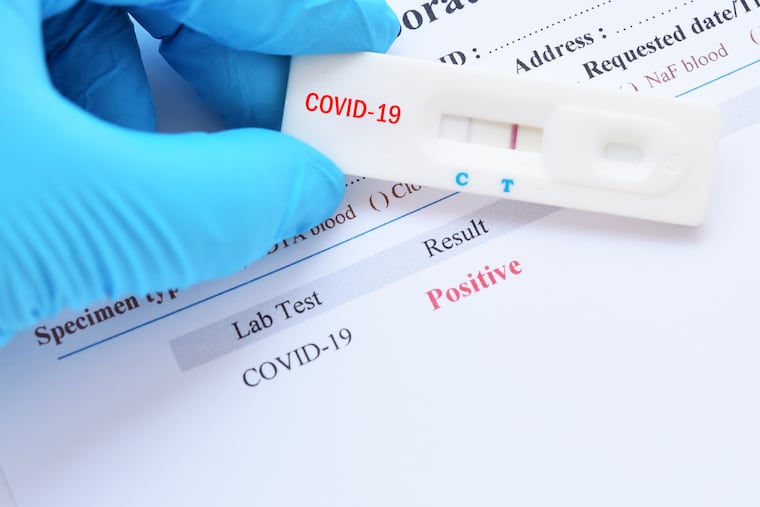An epidemiologist who studies COVID-19 tested positive. Here’s what she learned. | Expert Opinion
The moral of my story is not one of shame, either of the venue, myself, or anyone else involved in my exposure to the virus. Instead, the message is this: We have entered a new era of the pandemic.

“If you can get it, anyone can!”
That was pretty much the unanimous response I got when I texted family and friends that I had tested positive for COVID-19 recently. As an epidemiologist researching SARS-CoV-2 transmission in Philadelphia, I had a pandemic life that was more isolated than most; there’s no better prophylactic for COVID-19 than spending every workday incessantly thinking about viral transmission and how your actions can have dire consequences.
This expertise, combined with a diagnosed anxiety disorder that pushes me toward overcautious behaviors at the best of times, led me to become somewhat of a poster child for adhering to public health guidelines. Even once I was fully vaccinated, I largely avoided eating indoors at restaurants and traveling on public transportation.
Even so, my COVID-19 test came back positive exactly one week before Christmas Eve. Before my diagnosis, I rarely left my home to go anywhere except work, the pharmacy, and the doctor. But in an attempt to embrace “post-pandemic” life in a seemingly safe way, I attended a concert at a venue with strict public health protocols.
Back in June, my friend and I purchased tickets to see MisterWives’ “Resilient Little Tour” in Philly. It was our favorite band, performing an album that resonated with me in terms of my own mental health trials and triumphs. As the date grew closer, I worried about attending an indoor concert, but I took comfort knowing that all attendees would be required to show proof of vaccination and photo ID to enter, as well as adhere to the masking policy.
On the evening of the concert last month, my friend and I relived our college tradition of prepping for a night out. We welcomed the smell of a hair straightener left plugged in a little too long as we struggled to open tubes of mascara sealed shut after months of going unused.
Resilient little thing, just like mama made you, no one needs to save you. The opening lines of the album’s title song captured our celebratory mood as we exited my Philly rowhouse, double-checking our bags for tickets, IDs, masks, and vaccination records.
Three days later, I had a sore throat. Two days after that, I tested positive for COVID. Fortunately, my symptoms have been mild, mostly just fatigue and the occasional cough.
I want to be clear: I have no scientific evidence that I was exposed to the virus at the concert. Even the most careful among us can encounter the virus, especially the highly contagious omicron variant, which is behind most new cases now and is causing so many breakthrough cases in the vaccinated.
Furthermore, the moral of my story is not one of shame, either of the venue, myself, or anyone else involved in my exposure to the virus. Instead, the message is this: We have entered a new, distinct era of the pandemic, and it is a novel beast.
We have been inundated by data and messages conveying that vaccines are protective against SARS-CoV-2 (which is true), and that it is safe to let down our guard in certain situations if we’re vaccinated (also true). However, preliminary data suggest that these statements might not be as applicable in the context of the new omicron variant.
COVID-19 case and hospitalization rates have been dramatically increasing across the U.S., and skyrocketing in New York City, which tends to be a canary in the coal mine for the rest of the country. The omicron variant is spreading like wildfire, accounting for most new cases in the U.S. within just two weeks. Vaccine breakthrough cases are growing in Philadelphia, and a vaccinated person can still spread the virus if infected – even if the person has no symptoms. While I don’t know for sure which variant I am infected with, I suspect it’s omicron.
There is still a lot we don’t know for sure about omicron, but we do know that it’s here and, in the words of another of my favorite musicians, Olivia Rodrigo, it’s brutal out here. This new era is a numbers game, and the more people we surround ourselves with, the more we increase our chances of getting exposed to omicron.
On an individual level, we need to again embrace the Swiss-cheese model of layering multiple protective measures (such as avoiding indoor gatherings and using high-quality KN95 or N95 masks) because while vaccination is a crucial protective measure, it alone is insufficient. On a community level, local public health departments need to reinstate pandemic safety guidelines immediately to flatten this new omicron curve.
And on a national level, we need to recognize that this pandemic will never end if we continue to pretend that it doesn’t exist, or that it’s over. None of these phrases is novel, but they are still applicable to our lives as we enter 2022.
So if you’re still looking for that catchy moral of the story, here it is: If a vaccinated, over-cautious epidemiologist can get COVID-19 in the age of omicron, you can, too. But illness doesn’t have to be inevitable. Two doses and a booster of either the Pfizer or Moderna vaccines are 75% protective against symptomatic disease. So be sure to schedule your booster ASAP. Omicron may be a novel beast, but this time we’re armed with weapons we didn’t have before, as well as proof that they work.
Katherine Strelau is a doctoral candidate studying epidemiology at the University of Pennsylvania.